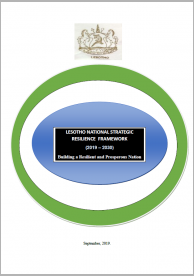Lesotho is especially vulnerable to storms, droughts and floods. The government is committed to DRR, prioritizing population’s resilience and preparedness.
The Disaster Management Authority, under the Prime Minister’s Office, is the main institutional body at the national level. Lesotho’s institutional framework for DRR and management also includes the National Disaster Relief Task Force and the District and Village Disaster Management Teams.
The Disaster Management Act, 1997, is the main legislative document guiding DRR and management in the country. In 2015, a National Drought Emergency Response Plan to address El-Nino weather conditions was published. Lesotho has developed a Resilience Framework and has implemented a Community Based Early Warning and Information Management System (UNISDR, Global Platform for Disaster Risk Reduction, 2020).
Moreover, the government also manifested the intention to integrate DRR in the school curriculum, to assist the conduction of Community Owned Vulnerability and Capacity Analysis and to develop infrastructure standards and codes (UNISDR, 2020). Lesotho does not have a climate change policy, although a Climate Change Policy and Strategy and a Sustainable Energy Strategy are being developed.
UNISDR (2020). Global Platform for Disaster Risk Reduction. Retrieved from Official Statements: https://www.unisdr.org/conferences/2017/globalplatform/en/programme/s…
Lesotho is a small mountainous country. Its climate varies essentially with altitude: it is temperate at the lowest elevations, which don't go, however, below 1,400 meters above sea level, while it gets colder with increasing altitude.
The capital, Maseru, is located at 1,600 meters above sea level, but most of the country is crossed by the Drakensberg range and lies above 2,000 meters; the highest peak is Thabana Ntlenyana, with its 3,482 meters.
In Lesotho, the weather is often unstable, with rapid changes in wind and temperature from day to day. Winter is the driest season, while summer is the rainiest. Snow is more common at high altitudes, above 2,000 meters, where rainfall is more abundant as well.

Regional Platform / DRR Contact Point
-
Government of LesothoOrganization type:
Risk reduction Policies, Plans & Strategies
Policies, plans and official statements on disaster risk, climate adaptation and resilience.

|
Appeal for Humanitarian Assistance - October 2019 to April 2020
This Appeal document has been prepared by the Government of Lesotho for presentation to its Development Partners, local business organizations, and citizens of good will to assist in addressing and redressing the current situation. |

|
Lesotho National Strategic Resilience Framework (2019-2030)
The Government has developed the National Resilience Strategic Framework (NRSF) to enable it to guide, coordinate and lead the process of resilience building in the country to ensure that Lesotho find a durable solution to address the multi-faceted challenges posed by climate induced shocks and s |

|
National Climate Change Policy
The policy provides strategic directions and coordination on issues of climate change, cognizant of its linkages with sustainable development. It identifies major vulnerable areas and risks presented by climate change. |
Documents & Publications
Disaster risk reduction and resilience publications, reports, research papers and case studies.

|
Lesotho Presentation - SADC DRR Project Inception Workshop
Lesotho presentation in the Strengthening Disaster Risk Reduction, Coordination, Planning and Policy Advisory Capacity of SADC Project Inception Workshop, held in Johannesburg, South Africa, 20-24 January 2020. |

|
2019 Drought Situation Report
Lesotho experienced drought from the start of the winter season up to date. The results of which is felt across the whole country whereby most of the districts reported water shortages for both human and livestock consumption. |

|
2019 Vulnerability Assessment and Analysis Report
The main objective was to analyse food and nutrition security, and vulnerability of the population of Lesotho in 2019/2020 consumption year. Provide policy makers, government and other stakeholders with information for decision making and development programming. |
Disaster Data & Statistics
Reports on disaster statistics, country profiles and additional resources on collecting disaster loss data.

|
INFORM Country Risk Profile - Lesotho
Index for Risk Management. |

